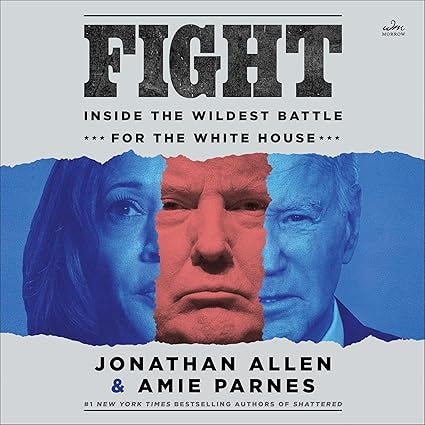The Vault
The first books about the 2024 election are out. Here's what one of them says about the role of oppo research in Trump's quest to recapture the White House
“You’ve written a hell of a book, and I don’t say that lightly,” California Governor Gavin Newsom said to Jonathan Allen and Amie Parnes, authors of FIGHT: Inside the Wildest Battle for the White House, when they appeared on his podcast. “It’s so well written,” Newsom said.
Intrigued, I added it to my Kindle.
A confession: When I read books about presidential campaigns, I perk up when the topic of opposition research wanders into the narrative. Fight did not disappoint.
Here are some takeaways:
#1: Team Harris circulated oppo research on her rivals for the vice presidential nod in 2020.
From the book, in a chapter titled “Fuckery”:
In 2020, when she [Harris] beat out a crowded field to join Biden’s ticket, Harris advisers ran a dark-arts operation to undermine the competition, circulating negative information on her rivals. “We stabbed Karen Bass a little bit. We stabbed Susan Rice a little bit. We stabbed Stacey Abrams a little bit,” one advisor said of the effort four years earlier. “We stabbed Gretchen Whitmer.”
Last year, I wrote about the role of oppo in the 2020 Democratic veepstakes. Here are some of the fingerprints those Harris aides left at the crime scene:
Rep. Karen Bass (D-CA) was forced to walk back effusive comments about the Church of Scientology after video surfaced of her remarks at a newly renovated church in 2001.
After former Obama aide Susan Rice vaulted to the top of Biden’s list, progressive columnist Alexander Sammon raised questions about her consulting career at McKinsey & Company and another outfit whose clients included “Rwandan strongman Paul Kagame.”
“I can’t remember any VP selection process where so much oppo research has been dumped,” former Obama advisor David Axelrod tweeted at the time. “If I were Joe Biden, looking for a good and loyal partner, that should be a source of concern.”
#2. Trump’s campaign, anticipating Biden might leave the race, ramped-up oppo research on potential replacements.
From the book:
The fear of a switcheroo lurked close enough that Trump’s campaign already had begun compiling political research on various Democratic candidates, including Harris. “We had started to test her, do opposition research her on a deep level, test messages against her, test our performance against her,” said one of Trump’s top campaign advisers.
The outlines of a campaign against Harris quickly emerged:
… a continuation of the “failed” Biden presidency with a more extreme leftward tilt. The vault was already stocked with clips of her endorsing the administration’s agenda, from “Bidenomics” to the withdrawal from Afghanistan. Her progressive-minded campaign for the 2020 Democratic presidential nomination - which ended before the first caucus - provided fodder for the extremism argument.
Based on what was in “the vault,” Trump aides thought Harris “looked like a disaster.” They believed Democrats would “spin their wheel for a while” and then select Pennsylvania Governor Josh Shapiro as their nominee.
#3. In the closing weeks of the campaign, Trump’s chief ad-maker wanted “something new.”
From Fight:
On a Friday afternoon in mid-September, [Patrick] McCarthy took a break from a lakefront reunion with college buddies to connect with his firm’s team. They were about to do a round of testing on prospective ads, and he wanted to put something new in the mix.
“What’s the craziest thing we’ve got on her,” McCarthy asked. The question was not totally out of left field - his firm actually kept a file called “crazy” with potential ad material that would portray Harris as a radical. The group tossed around issues before landing on a 2020 questionnaire Harris had filled out for the American Civil Liberties Union in her first bid for the presidency. She had pledged to make sure that transgender people who relied on the government for medical care - including those in prison and in immigration detention - would be able to have surgeries at taxpayer expense.
CNN’s Andrew Kaczynski launched the ACLU questionnaire into the campaign conversation with his report that ran on September 9. Trump brought it up during his televised debate with Vice President Harris the following day.
“It seemed too good to be true,” Allen and Parnes write, “and perhaps too much for voters to believe.” McCarthy cut an ad and showed it to the nominee on Trump Force One. “The former president approved of the direction but balked at one element,” Allen and Parnes write.
To guard against voters dismissing the claim as too ridiculous to be true - could Harris really want strapped taxpayers to fund transgender surgeries for prisoners? - McCarthy had inserted a clip of CNN’s Erin Burnett saying it was accurate.
“I don’t want her in the ad,’ Trump said of the host, who had often been critical of him.
McCarthy removed Burnett from the spot, versions of which then ran in key battleground states for the rest of the campaign.
I liked Fight and appreciate Newsom’s recommendation. He said he devoured the book “in a quick hour and a half, almost two hours.”
The book is 326 pages long. According to Kindle, the average reader will require 6 hours and 31 minutes to get through it. According to Grok, someone would need to read at a pace between 833 and 1,667 words per minute in order to finish the book within two hours. For reference, “advanced” speed-readers come in between 700 and 1,000 words per minute.
According to Wikipedia, “[s]cientific studies have demonstrated that reading—defined here as capturing and decoding all the words on every page—faster than 900 wpm is not feasible given the limits set by the anatomy of the eye.”
“I don’t read very fast,” Newsom told Allen and Parnes at the top of his podcast, “but it reads at an unbelievable pace.”
Unbelievable, indeed.




